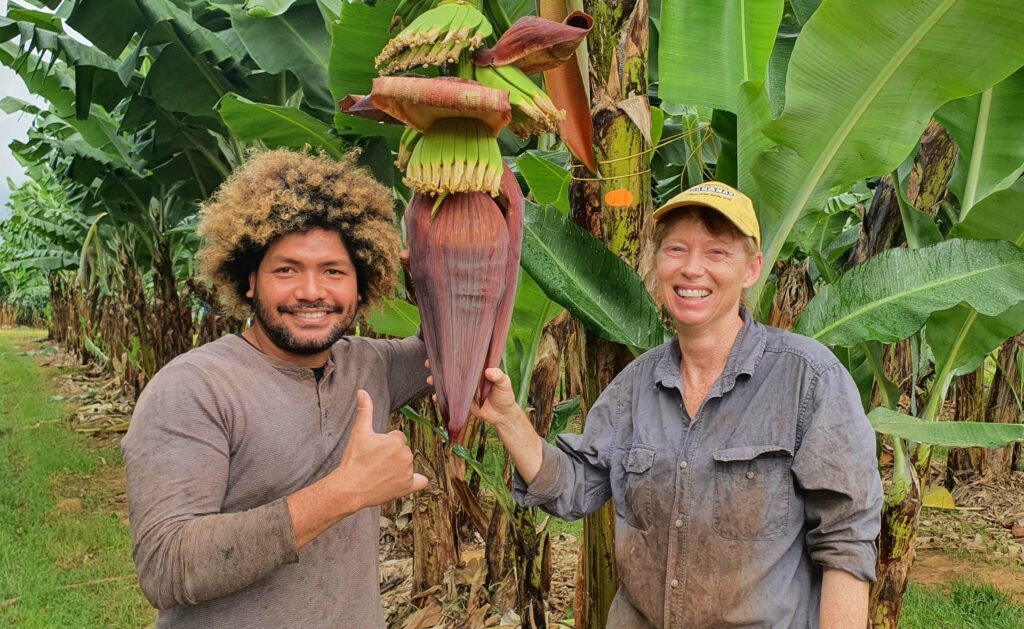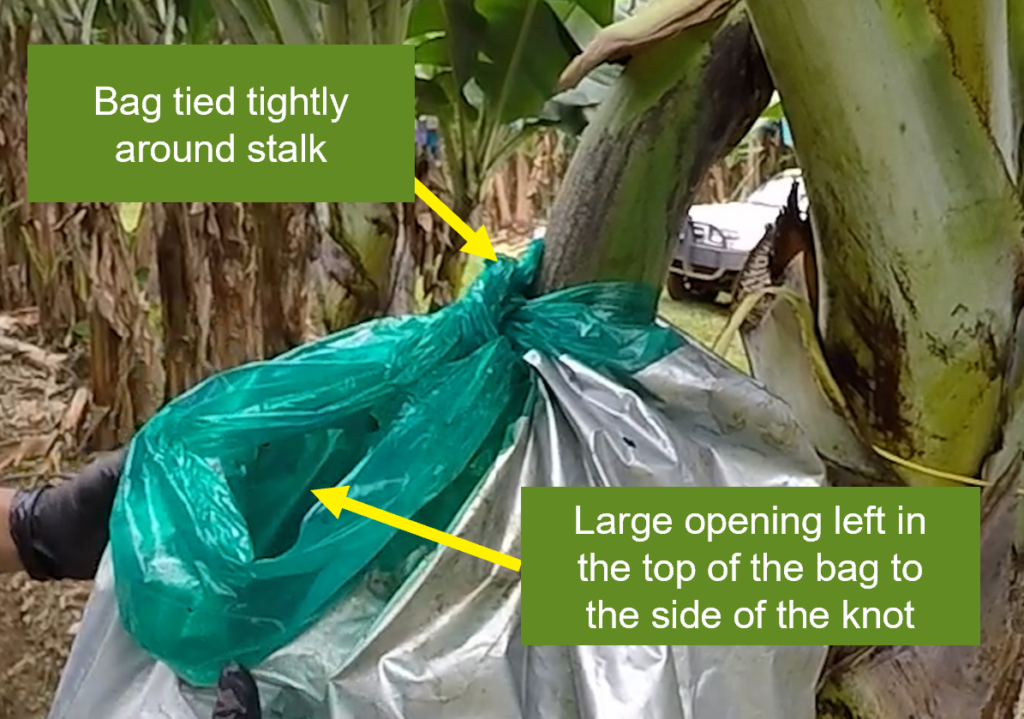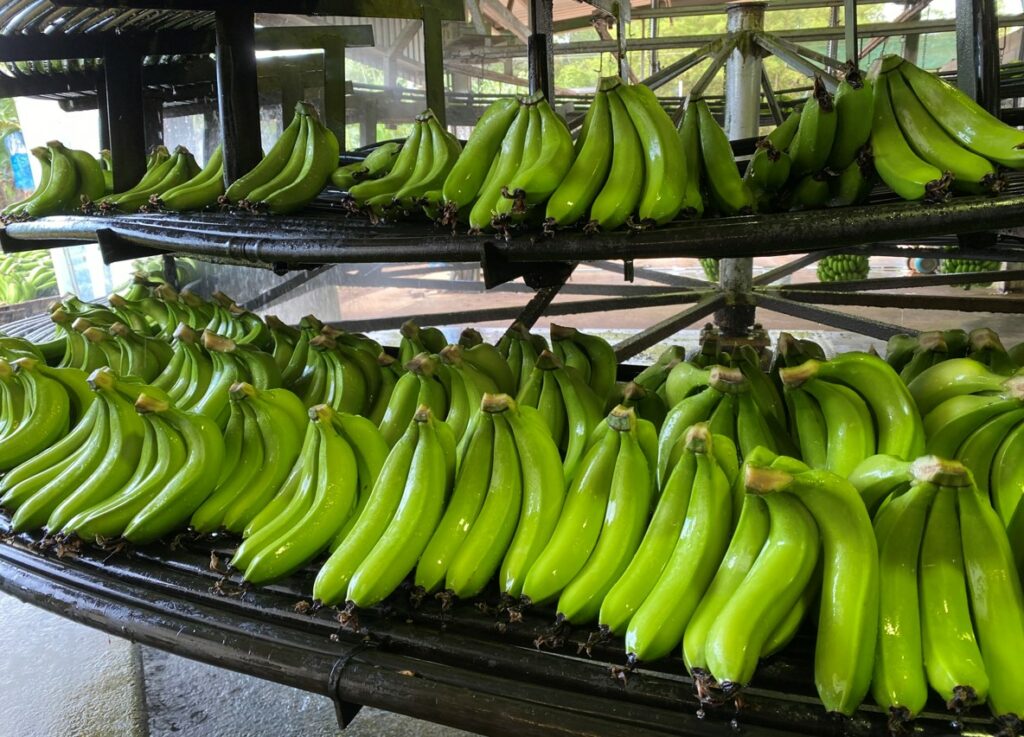Grower case study
Bagging technique improves fruit quality for Sellars Bananas
Experienced premium Cavendish grower Naomi Brownrigg is confident that their bagging technique which leaves a ‘flue’, has improved fruit quality by reducing fungal and mould issues.
Naomi continues to see the benefit of this technique, implementing it on their family farm over 20 years ago.
Naomi says the flue bagging technique has dramatically reduced fungal and mould issues. ‘From that moment on (leaving a flue in the bag) we haven’t really had an issue. It will only be if the flue closes up you might get a mouldy bunch, after that we were free of it,’ Naomi said.
‘We’ve adopted that technique on our family farm for 20 years now and it’s so easy to do.’

Sharing lessons learnt for the benefit of industry
Naomi is passionate about helping other growers improve their fruit quality and is willing to share her knowledge and experience of lessons learnt.
Sellars Bananas transitioned from bunch dusting with chlorpyrifos and talc to using a bunch spray with chlorpyrifos. This was to eliminate the risk of fruit being rejected at market due to talc residue. When they made the switch Naomi said they experienced significant decline in fruit quality due to increased fungal and mould issues. ‘At first we weren’t leaving any air hole (flue) in the bag. The bags did have perforated holes in them and we were just tying them up like normal and putting the spray in,’ Naomi said. It was her husband Dave who first noticed they had an issue ‘he said we have a huge problem out there. He said I can see all the fruit sweating and the mould starting,’ Naomi said.
Naomi said the type of bags they used at the time also contributed to the problem, as they didn’t hold their shape and instead closed around the fruit. Naomi explained it’s important for growers to ensure the bags they use don’t close up.
With chlorpyrifos currently under review by the Australian Pesticides and Veterinary Medicines Authority (APVMA), the permit to apply chlorpyrifos mixed with talc may be cancelled or not renewed once the current permit expires. This will leave only spray application of registered insecticides to control banana bunch pests.
Some growers have reported increased incidence of mould and fungal issues using a bunch spray compared to dusting. It’s suggested that bunch spraying increases the amount of moisture in the bag and combined with high temperatures, may lead to increased humidity and fungal issues. Market agents have also confirmed fruit continues to be rejected due to talc residues. Naomi hopes that sharing their bagging technique will help growers who are currently experiencing fungal issues affecting fruit quality, and those who are looking at transitioning from dusting to bunch spraying in the future.
In light of the APVMA review and continued market rejections due to talc residues, Naomi encourages growers to start trialling it. ‘Now is the time to be trialling these things. People are getting rejected at the supermarket level for talc at the moment and that pressure isn’t going to go away,’ Naomi said.
Flue bagging technique
The term ‘flue’, simply refers to an opening. Its use in this circumstance is designed to increase air flow through the bag and reduce humidity.
The key points to the bagging technique used by Sellars Bananas are:
⦁ A liner is applied first to emerged bells and tied tightly around the bunch stalk with no flue (Figure 1).
⦁ At pruning, bags are tied with a knot tightly around the stalk, not wrapped. The excess bag is left open (Figure 2).
⦁ The bag around the opening is folded down on itself to improve integrity and stop it from closing.
⦁ All bracts are removed to further reduce moisture within the bag.


Sellars Bananas achieve control of rust thrips
When the banana extension team discussed this technique with growers, some have raised concern the flue may provide an avenue for rust thrips to enter the bunch.
Naomi said this has not been their experience and believes that the bag being tied tightly around the stalk, acts as a barrier preventing rust thrips from moving down the stalk. In addition, the use of a liner, also tied tightly around the bunch stalk (without a flue) may help limit movement of rust thrips into the bunch.
Of course it is never one single practice in isolation and other bunch protection practices are also important for control of rust thrips. ‘If it has been injected on time, bagged on time and sprayed properly, we haven’t had a drama. We throw very little fruit away to rust thrips,’ Naomi said.

Every farm has different management practices and pest pressure and it’s therefore recommended that growers trial this bagging technique to make their own assessment before implementing it as a standard practice.
Watch the video below for a demonstration of the bagging technique
Thank you to Naomi Brownrigg and the team at Sellars Bananas who provided their time and gave permission to use this case study for the benefit of the wider industry.
If you would like further information or assistance with bunch pest practices, please contact the National Banana Development and Extension Team on email betterbananas@daf.qld.gov.au or phone 07 4220 4152.
This case study has been produced as part of project BA19004 the National Banana Development and Extension Program which is funded by Hort Innovation, using the banana industry research and development levies, co-investment from the Department of Agriculture and Fisheries and contributions from the Australian Government. Hort Innovation is the grower-owned, not-for-profit research and development corporation for Australian horticulture.


